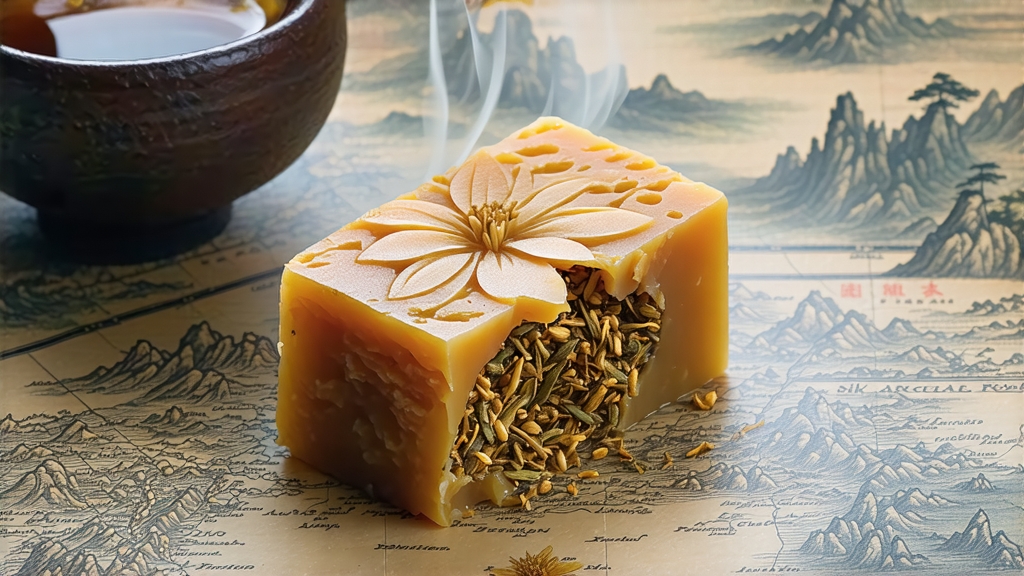
Among the six major chromatic families of Chinese tea, dark tea—hei cha—remains the most enigmatic to global drinkers. Within that shadowed realm, Fu brick tea (Fú zhuān chá) stands out as both the most fragrant and the most scientifically intriguing. Produced exclusively in the humid mountain counties of Hunan Province, Fu brick is not merely oxidized; it is coaxed into a second life by a microorganism that appears nowhere else in the tea world. The result is a mellow, malty liquor whose sweetness lingers longer than many fine wines, and a cake that appreciates in value the way Burgundy does in barrels.
-
From Horse Caravans to National Treasure
The story begins in the 1360s, when the Ming court replaced the loose-leaf tribute system with compressed bricks to ease transport along the Tea-Horse Road. Caravans leaving Anhua County carried rough, smoky maocha toward the Tibetan plateau and the Mongolian steppe. Somewhere on the fog-shrouded trails, porters noticed that the half-fermented bricks grew a golden fuzz during the humid journey, and the tea tasted smoother, sweeter, and less likely to upset stomachs already churned by yak butter. By the Jiajing era (1522–1566), this accidental bloom had become deliberate craft. The imperial government granted the name “Fu” (府) because the bricks were pressed in government-licensed workshops (fu) in the small city of Jingyang, just south of the Miluo River. Over the next four centuries, Fu brick became the currency of the northwest: one brick bought two sheep, ten bricks bought a camel, and a caravan leader’s wealth was measured by the height of his tea stack. -
The Fungus That Signs Its Name
What distinguishes Fu brick from every other dark tea is Eurotium cristatum, a harmless mold that colonizes the interior of the brick under precise conditions of 26–28 °C and 70–75 % relative humidity. Chinese traders call the spore clusters “golden flowers” (jīn huā) because they appear as brilliant yellow specks no larger than a pinhead, scattered like pollen across the broken leaf. Far from being spoilage, the fungus secretes enzymes that convert residual cellulose into soluble sugars and cleave bitter catechins into softer theaflavins. The result is a dramatic drop in astringency and the appearance of a honey-like note that connoisseurs describe as “sweet potato in a sun-warmed field.” Modern biochemical analysis shows that golden flowers also synthesize a unique polyketide, fusaruside, that exhibits mild lipid-lowering activity—one reason Fu brick is marketed in China as “the blood cleanser of the prairie.” -
Crafting a Living Brick
The journey from leaf to brick unfolds in six tightly choreographed acts.
Act I: Withering and Fixing
Fresh leaves of the local Yun-Tai large-leaf cultivar are spread on bamboo racks for 4–6 hours to lose 15 % moisture, then pan-fired at 280 °C for three minutes to arrest green character.
Act II: First Rolling and Pile-Fermentation
While still warm, the leaf is rolled into tight strips and piled 70 cm deep inside pine-lined rooms. Workers mist the pile every 12 hours, maintaining a core temperature of 45 °C. Over 18 hours, the leaf turns from jade to copper, acquiring the earthy aroma of wet autumn leaves.
Act III: Steaming and Stacking
The semi-fermented maocha is steamed for 90 seconds to soften, then stacked into 1.5-meter towers wrapped in cotton. Here the leaf “rests” for three days, allowing internal moisture to equalize—a step critical for uniform mold colonization later.
Act IV: Brick Pressing
Traditional presses carved from camphor wood are lined with cotton cloth. Exactly 1.975 kg of leaf is tamped into each iron mold, producing a brick 35 cm × 18 cm × 4 cm—dimensions set in 1839 to fit seven bricks per yak saddlebag. A hydraulic press exerts 50 metric tons of pressure for eight minutes, binding the leaf so tightly that a dropped brick will ring like ceramic.
Act V: Golden Flower Incubation
The bricks are transferred to the “flower room,” a subterranean chamber kept at 28 °C by smoldering charcoal braziers. Over